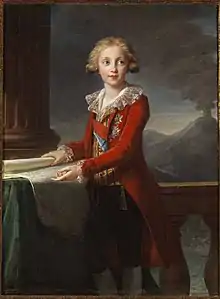Francis I of the Two Sicilies
Francis I of the Two Sicilies (Italian: Francesco Gennaro Giuseppe Saverio Giovanni Battista; 19 August 1777 – 8 November 1830)[1] was King of the Two Sicilies from 1825 to 1830 and regent of the Kingdom of Sicily from 1806 to 1814.
| Francis I | |||||
|---|---|---|---|---|---|
| Infante of Spain | |||||
.jpg.webp) Portrait by Vicente López y Portaña, 1829 | |||||
| King of the Two Sicilies | |||||
| Reign | 4 January 1825 – 8 November 1830 | ||||
| Predecessor | Ferdinand I | ||||
| Successor | Ferdinand II | ||||
| Born | 19 August 1777 Royal Palace of Naples, Naples, Kingdom of Naples | ||||
| Died | 8 November 1830 (aged 53) Naples, Kingdom of the Two Sicilies | ||||
| Burial | |||||
| Spouse | |||||
| Issue Detail |
| ||||
| |||||
| House | Bourbon | ||||
| Father | Ferdinand I of the Two Sicilies | ||||
| Mother | Maria Carolina of Austria | ||||
| Religion | Roman Catholicism | ||||
| Styles of Francis I of the Two Sicilies | |
|---|---|
 | |
| Reference style | His Majesty |
| Spoken style | Your Majesty |
Early life

Francis was born the son of Ferdinand I of the Two Sicilies and his wife Archduchess Maria Carolina of Austria in Naples. He was also the nephew of Marie Antoinette and Louis XVI, the last King and Queen of France before the first French Republic.
At the death of his older brother Carlo, Duke of Calabria in 1778, Francis became the heir-apparent to the thrones of Naples and Sicily with the title Duke of Calabria, the traditional title of the heir apparent to the Neapolitan throne.
Later life
In 1796 Francis married his double first cousin Archduchess Maria Clementina of Austria, daughter of Leopold II, Holy Roman Emperor. When she died in 1801, he married his paternal first cousin María Isabella, youngest daughter of King Charles IV of Spain. His youngest sister, Princess Maria Antonia of Naples and Sicily also married Maria Isabella's elder brother, the future Ferdinand VII of Spain, then Prince of Asturias.
After the Bourbon family fled from Naples to Sicily in 1806, Lord William Bentinck, the British resident, had drafted a new constitution along British and French lines. Ferdinand agreed to abdicate his throne, with Francis being appointed regent in 1812.[2]
On the abdication of Napoleon I, his father returned to Naples and suppressed the Sicilian constitution, incorporating his two kingdoms into that of the Two Sicilies (1816); Francis then assumed the revived title of duke of Calabria. While still heir apparent he professed liberal ideas, and on the outbreak of the revolution of 1820 he accepted the regency, apparently in a friendly spirit towards the new constitution, although he was actually as conservative as his father.[3]
On succeeding to the throne in 1825, he pursued a conservative course.[4] He took little part in the government, which he left in the hands of favourites and police officials, and lived with his mistresses, surrounded by soldiers, ever in dread of assassination. During his reign the only revolutionary movement was the outbreak on the Cilento (1828), repressed by the Marquis Delcarretto, an ex-Liberal.[3] He was, however, successful in having the Austrian occupation force withdrawn (1827), thereby relieving a large financial burden on the treasury.
During his reign, the Royal Order of Francis I was founded to reward civil merit.
Issue
With Maria Clementina of Austria:
- Maria Carolina (1798–1870), who married, firstly, Charles Ferdinand, Duke of Berry, the second son of King Charles X of France; and secondly, Ettore Count Lucchesi Palli, Prince di Campofranco, Duke della Grazia.
- Ferdinando, Duke of Noto (1800–1801).
With Isabella of Spain:
- Luisa Carlotta (1804–1844), who married her mother's younger brother Infante Francisco de Paula of Spain.
- María Cristina (1806–1878), who married firstly her uncle Ferdinand VII of Spain (her mother's older brother); and secondly, Ferdinand Muñoz, Duke of Rianzares.
- Ferdinand II of the Two Sicilies (1810–1859), who became Francis I's successor and married twice.
- Carlo Ferdinando, Prince of Capua (1811–1862), who morganatically wed Penelope Smyth and had issue.
- Leopoldo Beniamino, Count of Syracuse (1813–1860), who married Princess Maria of Savoy-Carignan. No issue.
- Maria Antonia (1814–1898) who married Leopold II, Grand Duke of Tuscany.
- Antonio Pasquale, Count of Lecce (1816–1843).
- Maria Amalia (1818–1857), who married Infante Sebastian of Portugal and Spain.
- Maria Carolina (1820–1861), who married Don Carlos de Bourbon, Count of Montemolin, Carlist pretender to the throne of Spain.
- Teresa Cristina (1822–1889), who married Emperor Pedro II of Brazil.
- Luigi Carlo, Count of Aquila (1824–1897), who married Januária, Princess Imperial of Brazil (sister of Pedro II of Brazil and Maria II of Portugal). Had issue.
- Francesco di Paola, Count of Trapani (1827–1892), who married Archduchess Maria Isabella of Austria, Princess of Tuscany, and had issue.
Ancestry
| Ancestors of Francis I of the Two Sicilies[5] | |||||||||||||||||||||||||||||||||||||||||||||||||||||||||||||||||||||||||||||||||||||||||||||||||||||||||||||||||||||||||||||||||||||||||||||||||||||||||||||||||||||||||||||||||||||||||||||||||||||||||||||||||||||||||||||||||||||||||||||||||||||||||||||||||||||||||||||||||||||||||
|---|---|---|---|---|---|---|---|---|---|---|---|---|---|---|---|---|---|---|---|---|---|---|---|---|---|---|---|---|---|---|---|---|---|---|---|---|---|---|---|---|---|---|---|---|---|---|---|---|---|---|---|---|---|---|---|---|---|---|---|---|---|---|---|---|---|---|---|---|---|---|---|---|---|---|---|---|---|---|---|---|---|---|---|---|---|---|---|---|---|---|---|---|---|---|---|---|---|---|---|---|---|---|---|---|---|---|---|---|---|---|---|---|---|---|---|---|---|---|---|---|---|---|---|---|---|---|---|---|---|---|---|---|---|---|---|---|---|---|---|---|---|---|---|---|---|---|---|---|---|---|---|---|---|---|---|---|---|---|---|---|---|---|---|---|---|---|---|---|---|---|---|---|---|---|---|---|---|---|---|---|---|---|---|---|---|---|---|---|---|---|---|---|---|---|---|---|---|---|---|---|---|---|---|---|---|---|---|---|---|---|---|---|---|---|---|---|---|---|---|---|---|---|---|---|---|---|---|---|---|---|---|---|---|---|---|---|---|---|---|---|---|---|---|---|---|---|---|---|---|---|---|---|---|---|---|---|---|---|---|---|---|---|---|---|---|---|---|---|---|---|---|---|---|---|---|---|---|---|---|---|---|
| |||||||||||||||||||||||||||||||||||||||||||||||||||||||||||||||||||||||||||||||||||||||||||||||||||||||||||||||||||||||||||||||||||||||||||||||||||||||||||||||||||||||||||||||||||||||||||||||||||||||||||||||||||||||||||||||||||||||||||||||||||||||||||||||||||||||||||||||||||||||||
References
- De Majo, Silvio. "FRANCESCO I di Borbone, re delle Due Sicilie". Retrieved 2014-08-14.
- "Francis I | king of the Two Sicilies".
- Chisholm 1911.
- "Francis I | king of the Two Sicilies".
- Genealogie ascendante jusqu'au quatrieme degre inclusivement de tous les Rois et Princes de maisons souveraines de l'Europe actuellement vivans [Genealogy up to the fourth degree inclusive of all the Kings and Princes of sovereign houses of Europe currently living] (in French). Bourdeaux: Frederic Guillaume Birnstiel. 1768. pp. 1, 9.
- This article incorporates text from a publication now in the public domain: Chisholm, Hugh, ed. (1911). "Francis I. of the Two Sicilies". Encyclopædia Britannica. Vol. 10 (11th ed.). Cambridge University Press. p. 936.